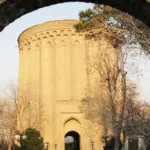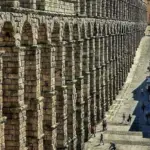Nestled in the vast expanse of the Libyan desert lies an extraordinary natural marvel known as The Valley of the Planets, or Kawakeb. This breathtaking wonder is situated in the Wan Tikofi Valley, near the mountain town of Ghat in southwest Libya. With its enigmatic rock formations and otherworldly charm, the site has captivated geologists, historians, and travelers for centuries.
Let’s dive into the intriguing details of Kawakeb and explore why it stands as a testament to nature’s artistry and mystery.

The Origins of Kawakeb’s Name
The Valley of the Planets owes its name to its peculiar geological formations that resemble planets from our solar system. These spherical and rounded rocks, locally called trovants, are scattered across the valley like celestial bodies on a galactic canvas. Their shapes, sizes, and arrangements evoke the image of a miniature solar system grounded on Earth.
These “planet-like” rocks have not only fueled the imagination of onlookers but have also inspired local legends and folklore. Stories about their origins, movement, and mystical properties have been passed down for generations, intertwining science with cultural heritage.
The Unique Features of Trovants
The trovants of Kawakeb are unlike any other geological formations found on Earth. Their uniqueness lies in their living-like characteristics, which defy conventional geological understanding. Here’s what makes them extraordinary:
1. Growth
Unlike ordinary rocks that remain static in size, trovants are known to grow gradually over time. This growth is attributed to their peculiar composition, which allows them to absorb and accumulate minerals from their surroundings.
2. Movement
Trovants can move slowly across the valley floor. While their movement is almost imperceptible to the naked eye, scientific studies suggest that it is influenced by environmental factors, such as water absorption and the expansion of mineral layers within the rock.
3. Reproduction
Perhaps the most baffling aspect of trovants is their ability to “reproduce.” Smaller rocks appear to form around larger ones, as if budding from their surfaces. This phenomenon continues to intrigue scientists and has led to the trovants being referred to as “living stones.”
4. Concentric Circles
When a trovant breaks open, its interior reveals concentric circles, much like the rings of a tree. These circles provide a glimpse into the rock’s growth history, further adding to their mysterious allure.
Like Us on Facebook!
Geological Origins and Theories
Despite their seemingly “alive” characteristics, trovants are primarily composed of sand and a binding material, such as calcium carbonate. They are believed to have formed millions of years ago in wet environments where minerals crystallized around sand particles.
Subscribe Us on YouTube!
How Do They Grow?
The growth process is thought to occur when water seeps into the rock’s porous surface. As the water evaporates, minerals left behind add layers to the rock, making it grow larger over time.
Why Do They Move?
The movement of trovants could be attributed to subtle shifts in the valley’s terrain, caused by wind, water flow, or underground geological activity. However, the exact mechanisms remain a topic of scientific curiosity.
A Place of Mystical Wonder
The Valley of the Planets is more than just a geological site; it is a place steeped in mysticism. For centuries, local tribes have regarded the trovants as sacred stones, attributing them with supernatural properties. Some believe they hold the power to bring good fortune, while others view them as guardians of the desert.
Travelers visiting the site are often struck by its surreal beauty and the palpable sense of awe that surrounds the valley. The trovants’ planetary appearance against the backdrop of the Libyan desert creates a visual spectacle that is both humbling and inspiring.
Tourism and Preservation Efforts
The Valley of the Planets has become a sought-after destination for adventurous travelers, geologists, and photographers. However, its remote location in the Libyan desert poses challenges for accessibility and tourism development.
Protecting the Valley
Preservation efforts are crucial to safeguard this natural wonder from human interference. With increasing awareness about its scientific and cultural significance, local authorities and international organizations are working together to promote sustainable tourism and protect the trovants for future generations.
The Valley’s Role in Science and Art
The Valley of the Planets continues to serve as a source of inspiration and discovery. Scientists study the trovants to better understand the geological processes that shaped them, while artists and storytellers draw from their mystique to create works that celebrate the intersection of nature and imagination.
Conclusion
The Valley of the Planets, with its “living” stones and celestial allure, is a rare gem in the world of natural wonders. Its enigmatic trovants challenge our understanding of geology and remind us of the endless mysteries that nature holds. Whether you are a scientist seeking answers, a traveler yearning for adventure, or an artist in search of inspiration, Kawakeb is a place that promises to leave an indelible mark on your soul.



















